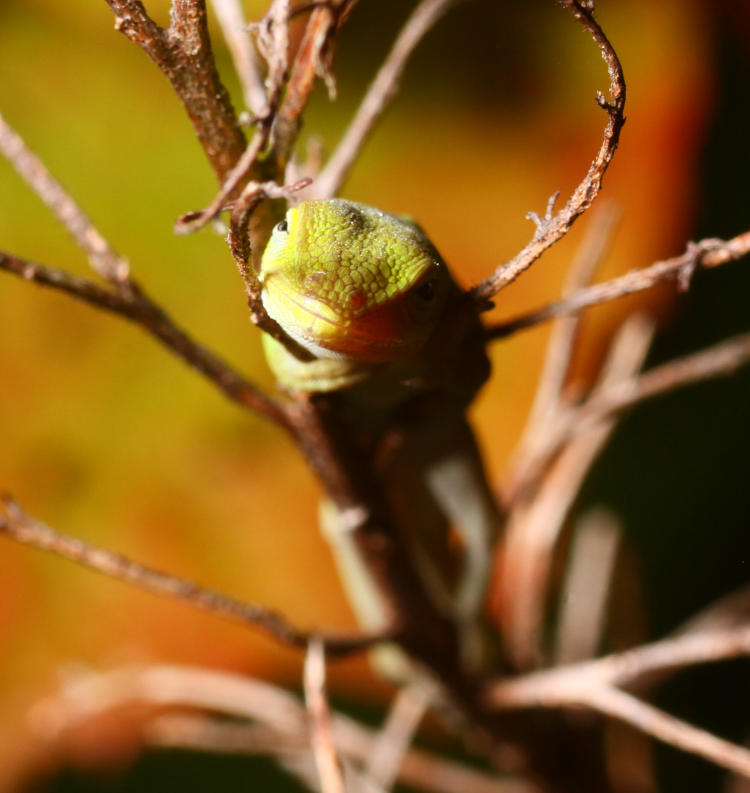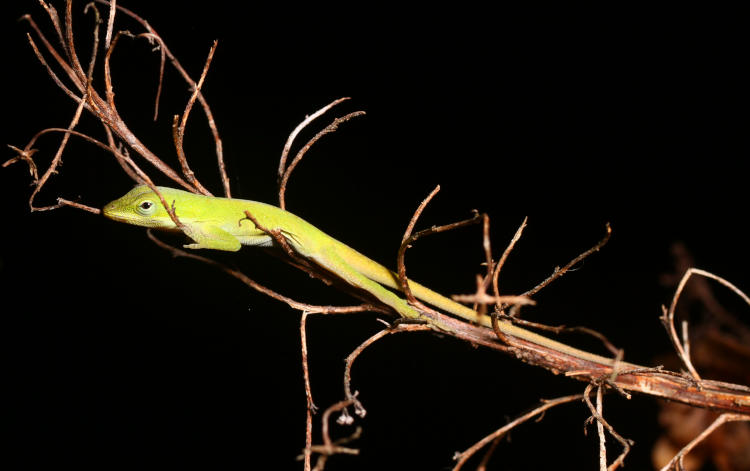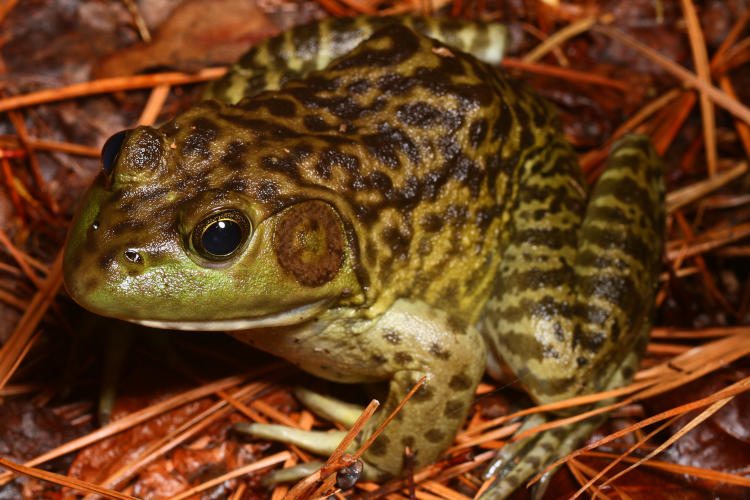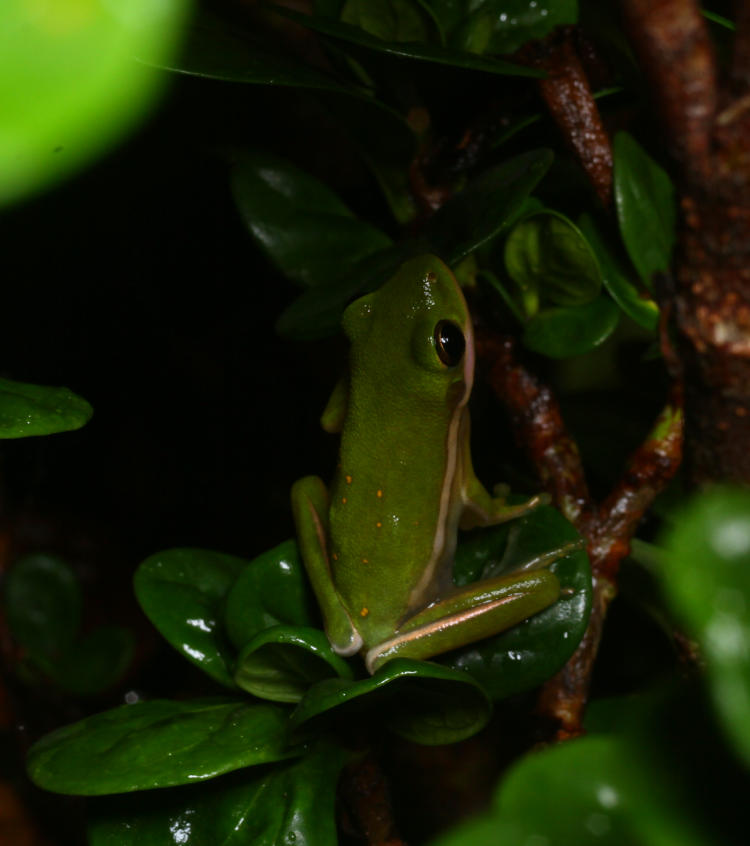As mentioned at the end of the previous post, I did indeed go out and get a few frames as intended, and then some more. And then I collected a particular subject for detail and did even more. But some of those go along with some video clips that I obtained as well, and editing the video is going to take a little time as it always does, so I decided to split these into two posts.
A couple of evenings ago, the sunset looked promising (having rained a couple hours before) and I went over to the neighborhood pond to pursue this potential. As usual, the sky laughed at me and produced nothing at all of interest, but on the way back, I checked the oak-leaf hydrangea (Hydrangea quercifolia) in The Jungle and, sure enough, the resident anole there was just seeking its sleepy-spot for the night.

I wasn’t planning on chasing this subject so I did not have the macro rig, and used the on-camera flash instead. This particular Carolina anole (Anolis carolinensis) has been seen and photographed numerous times before, including last year I suspect, and greatly favors this particular cluster of leaves at the end of a specific branch of the hydrangea. Since this was just after sunset, which is when they find their sleeping spot, I was interrupting the process here, but returned later on to check it out. You can see, out of focus in the foreground, some bare flower stems of the hydrangea, and it was to these that the anole retired. I had to go for a head-on perspective.

As is often the case, the anole became aware of my presence, possibly because of the whine of the charging capacitor in the macro flash, so I couldn’t achieve any frames with its eyes closed, but it remained where it was all the same. We need to go in closer for a particular detail:

Yep, that’s dew on its forehead, evidence of the dropping temperature. These were taken after I finished the previous post, but past midnight now so “early yesterday morning.”

I did a side shot to show the perch better, and I’ll point out that the tip of the anole’s tail extends out of the frame here. Since the anole is right back there again tonight, I just went out to get a specific measurement: about 85mm overall length, but from nose to vent (body length) it’s less than 40. Unfortunately, I found out how much of its complacency was due to not being able to see anything in the glare of the headlamp, because as the calipers got close to its nose and thus into the light, the anole considered this unkosher and bailed into the leaves below. I feel bad, but during the day the anole has full run of the entire area so it’s not ‘displaced’ or anything, just not in its favorite (for now) bedroom.
But back to the previous morning, when I realized the light would be better coming from the other side and juggled the bracket around accordingly.

Much better lighting now, and look at the little toes just barely gripping the branch. But this all reminded me that I need to redesign the macro flash bracket in two ways. First, a much easier attachment manner than a screw-to-tighten quick-release bracket that attaches to the mount that remains on the camera body, because this requires more hands than I have; it needs to simply ‘click’ on, even if I have to tighten it afterward. Part two is that it has to be able to rotate laterally from this mount, to switch the flash unit from left to right easily, because I have to do this too often and it’s extremely awkward, again, for non-octopods. Pondering how to make all this work.
Meanwhile, another subject from the same night.

This is the American bullfrog (Lithobates catesbeianus) that has taken up residence in the pond here at Walkabout Estates, and it’s about the size of my fist. It’s out every night, and quite complacent most of the time; if I don’t specifically get anything within the headlamp beam, I can often approach quite close. Quite close.

This is at maximum magnification with the Mamiya 80mm macro, sans the extension tube so not as close as it could be, but this places the lens within 160mm of the frog, and it didn’t twitch. I realized after I was finding this monster here that I was no longer seeing the three resident green frogs that had been in the pond, and suspect that they have fallen prey to this one – it’s big enough to take down mice and small snakes, and capable of it too. Then a few days back after one of the rains, I found a small green frog in the pond again. One of the residents that I’d missed? A new one? About to become another meal for Hugo here? I have no idea. One of these days I’ll snag this one just to get a weight, and I imagine it’s going to be a handful to manage this. I should probably have someone videoing it…
And two just from tonight, that I found in passing.

This juvenile green treefrog (Dryophytes cinereus) is about half adult size, hanging out on one of the front planters – I just liked the ready-for-action pose.

And this one, same species, is about half of that size and directly across the front walk from it, nestled deep within one of the gardenia bushes. It seems to have taken up residence among the same plants that used to host one of the newborn anoles, who now appear to have moved on – possibly not far, but not within regular sighting anyway. I just try to track their habits and haunts, slowly getting an idea of what their traits are. But yeah, I do need to find some more variety in species around here… though that’s what the video will accomplish too, so hang on a bit.




















































